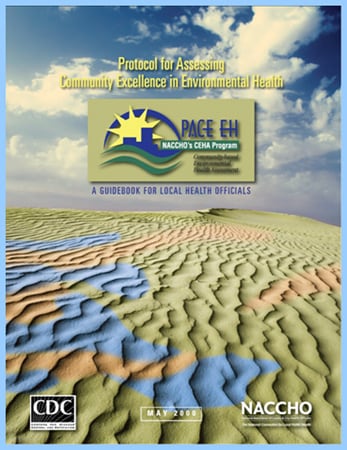PACE EH - Protocol for Assessing Community Excellence in Environmental Health
CDC’s National Center for Environmental Health (NCEH) and the National Association for County and City Health Officials (NACCHOexternal icon) partnered to develop the Protocol for Assessing Community Excellence in Environmental Health (PACE EH) pdf icon[PDF – 5.75 MB]. Representatives from federal agencies, academia, and research institutions, as well as local environmental health professionals and community organizers, provided overall direction and oversight for the project. The protocol was pilot tested by local health departments before it was finalized.

This methodology guides communities and local health officials in conducting community-based environmental health assessments. PACE EH draws on community collaboration and environmental justice principles to involve the public and other stakeholders in:
- Identifying local environmental health issues,
- Setting priorities for action,
- Targeting populations most at risk, and
- Addressing identified issues.
Why Use PACE EH in Your Community?
PACE EH processes can lead to action on those environmental health issues that both affect health and address community needs. In addition, some programs use the PACE EH process to conduct a community health assessment, a prerequisiteexternal icon for health departments applying for accreditation from the Public Health Accreditation Board.
PACE EH helps with implementation of the 10 Essential Environmental Public Health Services. One of the services is to inform, educate, and empower people about environmental health issues, and another is to mobilize community partnerships and actions to identify and solve environmental health problems. PACE EH can also help assure a competent environmental health workforce and improve the decision-making process by strengthening community involvement so that public values and priorities are considered.
PACE EH in Action: An Example from Wabasso, Florida
The Florida Department of Public Health used a PACE EH process in the community of Wabasso. pdf icon[PDF – 1.33 MB]external icon Private and public leaders in Wabasso identified their top health issues as
- Safe and healthy housing,
- Community safety from violence and drug trafficking,
- Street lighting,
- Accessible areas for safe physical activity and recreation,
- Access to safe drinking water, and
- Solutions to septic system failures and access to a municipal wastewater system.
The PACE EH process led to several civic improvements. Streetlights and sidewalks were installed. Abandoned homes were removed and existing homes repaired. Water lines were installed, septic systems improved, and parks enhanced, including the addition of a walking trail. The local health agency could not address these problems on its own. But health agency staff often knew whom to contact within the local government or community. Because of the improvements, survey respondents reported several benefits. Outdoor physical activity increased (80%), sense of well-being improved (94%), and trust in government to address concerns increased (91%). A $30,000 investment in the local health department’s staff time yielded more than $1.5 million in improvements.
Want To Learn More?
Are you ready to initiate a PACE EH or other community environmental health assessment in your community? Explore our PACE EH and other community involvement resources as well as our performance improvement resources.